Into the blue
One of the main things we wanted to do on arrival in the Galapagos was to dive. For a while it was looking as though it would only be me going, but luckily Nick recovered from the nasty cold he’d been suffering from the week before. So on arrival in Puerto Ayora, Santa Cruz one of our first jobs was to seek out a couple of dive companies and arrange two days of diving.
In the end we went with Scuba Iguana, they seemed to be the most professional of the companies we talked to – the only people to ask how many dives we had, when the last time we had dived was etc. Kind of key questions, I think. They also limited the number of divers to one dive master to 4 which was appealing.
Our first day was to North Seymour, which is an island just north of Santa Cruz, only about a 30 mins boat ride so not too far. It was a bit of a shock jumping in the first time, neither of us having dived for 18 months and the water was cold, actually the water the b****y freezing. None of this tropical Red Sea business! Soon came back to us though, not that difficult when the main thing to remember is to breathe!
We were lucky with our first dive – to begin with we didn’t see anything but blue and some rocks (which I guess were lava, given that all the islands are volcanic), and loads of garden eels but then we found ourselves swimming in amongst 30-40 eagle rays. Although fairly blurry because of the not so great visibility, you can still tell what graceful creatures they are. Such a priviledge. That dive we also saw big schools of barracuda and other fish. We also got very close to two big stingrays, a little too close for my liking!
The second dive was really cold, c. 16 degrees brr. The coldest dive I’ve ever been on. On this one we saw at least three turtles and I spotted a sea lion whilst the others were watching a big turtle in a cave. Amazing creatures under water with their eyes buldging and effortless swimming.
We also just swam out into the blue, hoping to catch a glimpse of hammerhead sharks, but no luck. The big blue experience was new to us and it was difficult to judge depth and to orientate youself but I really liked it.
The second day of diving saw us head to Beagle Rocks. This site isn’t visited by many other dive companies, which appealed to us. These are situated just off Santiago Island and are a group of three rocks sticking out of the ocean. There were loads of sea lions hanging out on the rocks when we arrived and we felt quite positive about spotting them whilst down below.
Cold again, and the visability was worse than at North Seymour. There is a theory that is because of the earthquake in Peru a couple of weeks ago shaking up loads of sediment which has drifted up on the currents, which sound plausible.
The main draw to this site is hammerheads, but we weren’t lucky enough to spot any on either dive. Just more turtles and sea lions, a couple of sharks in a cave (and quite a lot of fish) and then on our second dive of the day a manta ray swam past. Now these are something that I have wanted to dive with for years now and so was really happy to see it glide past. Somehow Nick missed it completely, despite being close to it!
We weren’t lucky enough to see hammerhead sharks, a famous Galapagos emblem, but the school of rays, manta, sea lions, turtles, massive schools of fish….certainly made up for it. And you forget just how cold you were on the surface interval and getting out of the second dive of the day fairly quickly…honest!
Just because our diving was over, it didn’t mean that we didn’t jump into the cold blue ocean again. Four times infact! Once in a lagoon on the north coast of Santa Cruz, once on Isabela island and twice on a tour of the bay around Puerto Ayora.
One of the most surprising snorkelling experiences we had was in a lagoon on the North side of Santa Cruz island. The guide mentioned something about sharks, but we weren’t really paying attention so when we suddenly saw a lagoon full (c.20 or so) of tiburones tintoreras (white tip reef sharks) it was quite a surprise! Suddenly felt very bare without a wet suit, in a pool only a couple of meters deep, but apparently they only eat small fish and crustations…then a couple of big sting rays swam past too; felt even barer then!!
We didn’t see anything in the Tintoreras lagoons around Isabela or on our second snorkel in the bay, apart from one huge marine iguana who dived very quickly once we jumped in and approached him (Nick saw him clinging onto the bottom, but I didn’t), but the first snorkel of the day at the Loberia was a different story.
To begin with it didn’t look promising, lots of lobos sitting in the sun on their beach watching us, but after about 10 minutes or so of us swimming backwards and forwards in front of the beach getting colder and colder, there were suddenly at least 10 if not 15 playing in the swell near some sharp rocks – they had come to watch us struggle in the swell and show off their swimming skills. What curious creatures diving up close to your mask (not sure if they are playing boo or looking at their reflection in your mask) and nibbling Nicks fins as he had to turn his back on them for a short while to stop himself being dashed on the rocks. They definately had the advantage in these conditions! It is so hard to describe what a feeling of elation you get when you have the priviledge of seeing such amazing creatures swimming so close to you, and its nice to be with creatures that have come to you to check you out rather than approaching animals that would rather get away if they could. Lets just hope that we get at least one good photo out of our disposable underwater cameras…we won’t find out until we get them developed at home.
Tags: Diving, Ecuador, Galapagos, North Seymour, Tintoreras, Travel, Travel

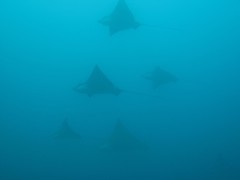
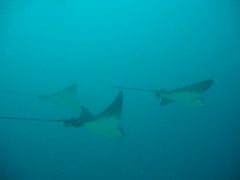



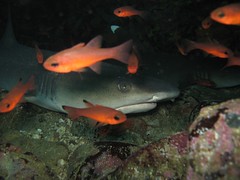
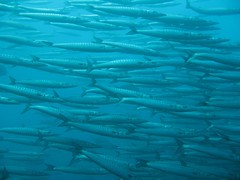
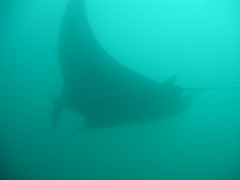
Leave a Reply